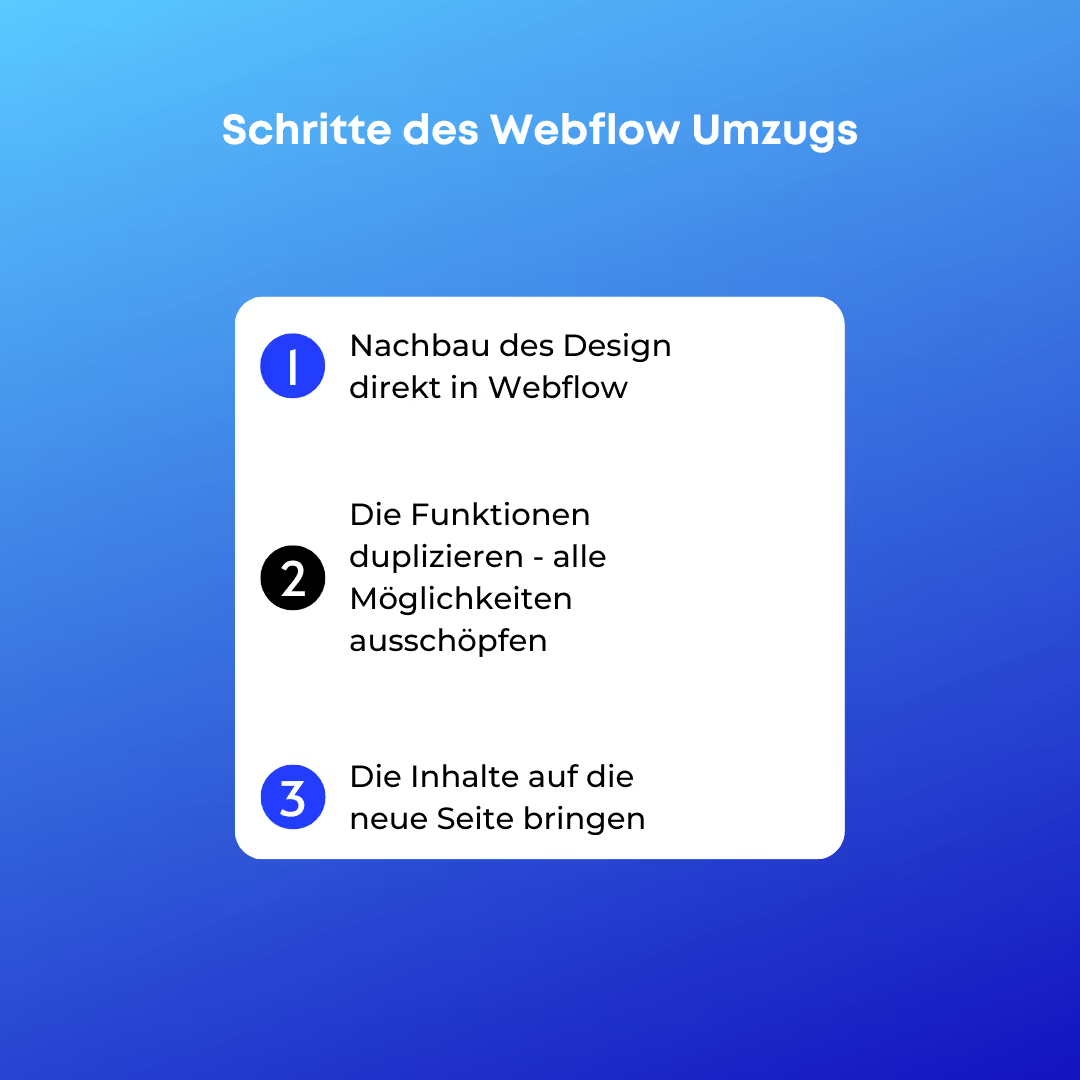WordPress is still one of the most frequently used systems for websites, blogs and corporate websites. However, the solution is not always the best choice for companies. If you are planning a WordPress move and want to switch to Webflow, you should consider a few points in advance. This makes moving WordPress to Webflow easy and uncomplicated.
The WordPress move to Webflow — you can expect these benefits
With Webflow, you can easily design a fully customizable website that meets the requirements, loads quickly and acts convincingly, even without programming knowledge. The drag-and-drop page builder offers a whole new level of freedom, as you don't have to laboriously switch between backend and frontend. Whether it's interactions or animations, all of these elements can be created and placed without programming knowledge. In addition, all pages are inherently SEO-friendly and optimized for mobile devices. So don't worry anymore about whether users can optimally access your site on their smartphones. You can also work on the website with multiple users at the same time and add new content, for example. Webflow also comes with a secure SSL certificate, so you don't have to worry about this security aspect either. Your new site can therefore convince both employees and customers across the board.

The steps of moving
First of all, it is important to determine how the previous website was structured and whether it is still up to date and up to date. Since WordPress can be used both as a content management system and contains static pages, these levels must be separated from each other before moving to WordPress. Because Webflow also offers the option of publishing both static pages and CMS content. The site map of the WordPress site can help to make the structure and structure of the website comprehensible.
Replica of the design directly in Webflow
First of all, the basic design of the website must be recreated if you want to stick to a consistent design. This is pleasantly easy thanks to the simple function directly in the frontend and helps you quickly see the results and make corrections. If you wish, you can therefore recreate the entire WordPress website so that the customer can no longer see any difference in the end. However, when moving to WordPress, it often makes more sense to carry out any necessary modernization and thus bring the website up to date with the latest technical standards. For subtleties of design, it may be necessary to intervene directly in the source code. However, this is much easier with a solution like Webflow, as a clean and easy-to-read source code is written. A significant difference to WordPress.
Duplicate the functions - exploit all possibilities
WordPress offers a clear number of functions out of the box. But plugins can be used to create many options in WordPress. If possible, these can also be recreated in Webflow. However, it is important that you first look at which functions are actually available on the website and whether you need any of these functions and options at all. If there are essential functions that you do not want or cannot do without in the future, these must also be considered when moving to WordPress. This can make it more complicated to reproduce them one-to-one. Because many things can then no longer be easily integrated via the Webflow interface, but these functions must be programmed by hand. This can make the WordPress move more cumbersome and require professional help.
Bring content to the new site
Once design and functionality have been completed, the content has to be transferred. This can even often be done simply by copy & paste from the old WordPress website, as texts, images and other media are very easy to transfer to the Webflow architecture. Here, it is necessary to carry out any necessary updates and check the data. Migrating data and content is therefore easy, as you can easily switch from the backend of WordPress to the frontend of Webflow.
Once all this work has been completed, the domain can simply be redirected to the new website. From this point on, the new website is online and fully functional.

You should take these precautionary measures
Such a WordPress move is not always easy to manage and can take a lot of time. This depends primarily on the complexity of the website and the amount of content. Therefore, before you start the move, you should first back up all data from the WordPress installation externally. This is important so that you can still access the entire website with all content in any case.
It is also a good idea to first test the new Webflow website in a controlled test environment and to check the various functionalities. External testers who already know the original WordPress website and should now test the new Webflow page are particularly suitable for this. This not only gives you good and clear feedback, but also makes it easier to identify errors in this process. The higher the number of testers, the more likely there are also statistically fewer errors, which you can correct before the actual WordPress move.
In any case, avoid destroying the data from the old WordPress installation immediately after the WordPress move, but keep the data backed up offline. This means that you always have a backup solution in case there are serious problems with the website. While this is unlikely with Webflow, it's not impossible. Therefore, moving to WordPress is a good and secure step, which should not be carried out without the precautionary measures mentioned above.
Only when you are satisfied with all tests and the results of them should you redirect the domain to the new address and thus complete the WordPress move. From this point on, the Webflow website is the only website still required and its data should also be backed up externally. This external backup should be repeated regularly, even if the risks are significantly lower than a WordPress installation. Among other things, because the code is more consistent and does not become confusing due to plugins, as we did in Webflow vs. WordPress Have worked out the guidebooks in more detail.
You have to pay attention to this when moving to WordPress
Basically, almost every function of WordPress can be rebuilt in Webflow. This applies both to static pages and to pages as part of a content management system. Before moving to WordPress, it is important to familiarise yourself with the plugins and their functions that are used on the WordPress website. Because in many cases, these are essential for specific areas or specific functions. This means that when moving to WordPress, the functions of the plugins must also be recreated.
This can't always be easy and straightforward. Because this is also where the Low-code approach to its limits. It may therefore be necessary to have these functions programmed by experts so that the WordPress migration works one-to-one. Alternatively, as a company, you can also consider whether these functions are essential for the website and its use or whether there may be workarounds or changes that make these functions unnecessary. However, these are always individual decisions that depend on the overall web design and usability of the website.
A WordPress move can often also be a good opportunity to redesign and modernize parts of your own website. In this process, changes can also be made to usability, page layout or page management. Webflow offers optimal support here, as you can work directly on the front end. This makes the WordPress move to Webflow even more pleasant.
Start looking for support early
Such a WordPress move to Webflow can therefore involve considerable effort. Especially if you and your team have no idea how to design a website nor would like to take a closer look at the topic of Webflow. In these cases, we advise you to seek help and support for the WordPress migration. Because as easy as designing a website using Webflow is, if you want to carry out a WordPress move and retain all the features of WordPress whenever possible, the work should be done by experts who can also work manually on the source code in an emergency. Here, companies usually do not have their own teams and specialists who take over them. If you have such a team in your own IT, support is still helpful. This can make the WordPress move much smoother, at least at the beginning. However, companies are also asking themselves who could offer support.
Freelancer or Webflow agency? Which is better?
For the WordPress migration, you can rely on the help of freelancers or a Webflow agency. We are generally more likely to recommend an agency, as this offers significant advantages. A good Webflow agency usually already has experience with a WordPress move and has both WordPress and Webflow experts. In addition, several experts are united in a team and can therefore complete the work faster and in a more structured way. This means that the WordPress migration is not only faster, but can also be handled more professionally. In addition, ideally, you won't have to wait any longer for the WordPress move because the freelancer will be out. If an expert fails at a Webflow agency, their work can usually be taken over by other employees.
Moving WordPress to Webflow is not easy, but it pays off significantly
As you can see, moving WordPress to Webflow isn't always easy because many of the elements are not compatible and therefore have to be rebuilt from scratch. For this reason, it is all the more advisable to contact experts who will do this work for you. With a suitable Webflow agency, the WordPress migration is much easier and, above all, can be completed faster and more securely. Although the move is complex, we still recommend taking this step. Because although WordPress is fantastic software that can be adapted to many different circumstances, it is also constantly exposed to major attacks due to its structure and distribution. In addition, not all elements can be individualized as companies often need. With Webflow, on the other hand, you can choose from a powerful developer tool with comprehensive CMS functions, which offers you significantly more security and much more freedom. You'll be surprised how many new options and options arise after the WordPress move and how much the performance of a website can be improved. Because the great freedom offered by Webflow means, among other things, that you can react much faster to trends and new developments, making your website significantly more attractive for visitors and customers. And you don't have to miss out on any of the features that you particularly liked about WordPress. Because these can be easily adopted and adapted as part of the WordPress migration. Following the WordPress move, Webflow offers a significant range of new opportunities for your company and your business success.









Recommend this post